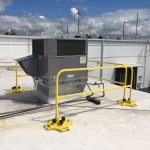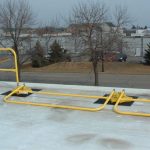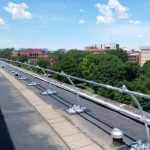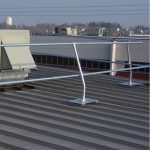Non-Penetrating Guardrails: A Design Available For Every Need
 FallProof Systems LLC has designed, provided, and installed non-penetrating guardrail on rooftops and elevated surfaces throughout construction sites and general industry locations. Guardrails are becoming a leading choice for building owners to protect workers and personnel from fall hazards.
FallProof Systems LLC has designed, provided, and installed non-penetrating guardrail on rooftops and elevated surfaces throughout construction sites and general industry locations. Guardrails are becoming a leading choice for building owners to protect workers and personnel from fall hazards.
No matter your industry, guardrails are a vital part of your workplace protection strategy. Though guardrails often go unnoticed or ignored, they are an important fixture in every OSHA-compliant facility.
The Basics of Non-Penetrating Guardrails:
Non-penetrating guardrails are not physically anchored to a surface – they’re not bolted down, glued, or attached in any other way. Therefore, no drilling or penetrations are required into expensive roofing or flooring systems avoiding damages to the roof. Instead, their horizontal rails remain compliant with OSHA’s 200-pound load requirement by utilizing counterweighted baseplates.
Often referred to as “temporary” guardrails non-penetrating systems can either be permanent or temporary safety solutions. Non-penetrating guardrails are removable, transferable, and OSHA-compliant when used as permanent fixtures. Added benefits of non-penetrating guardrails are passive systems that can function without any action from users and protect workers for as long as they are up. Passive fall protection systems need little to no maintenance, can be installed with minimal training, and do not require annual inspections. Non-penetrating guardrails protect both the workers, the structure, and are an easy solution to eliminate fall hazards at the work place.
Design Options
When it comes to choosing the right guardrail for your facility, you’ve got a few choices:
Collapsible Guardrails:
 Collapsible guardrail is a great solution when you are looking to keep the visual appeal of your facility. The guardrail system includes bases with a one-way pivot system that allow the rails to be lowered when they are not in use. Collapsible guardrails actually fold so they’re not seen while architectural guardrails are manufactured to stand upright.
Collapsible guardrail is a great solution when you are looking to keep the visual appeal of your facility. The guardrail system includes bases with a one-way pivot system that allow the rails to be lowered when they are not in use. Collapsible guardrails actually fold so they’re not seen while architectural guardrails are manufactured to stand upright.
Architectural Non-Penetrating Guardrails:
 Architectural non-penetrating guardrails are curved away from the roofs’ edge to ensure the presence of safety equipment does not distract from the overall appearance of a facility. These guardrails are especially common on rooftops with buildings housing a “green roof.” Architectural non-penetrating guardrails provide a great solution for fall protection while keeping the visual appeal of your facility intact.
Architectural non-penetrating guardrails are curved away from the roofs’ edge to ensure the presence of safety equipment does not distract from the overall appearance of a facility. These guardrails are especially common on rooftops with buildings housing a “green roof.” Architectural non-penetrating guardrails provide a great solution for fall protection while keeping the visual appeal of your facility intact.
Standing Seam Non-Penetrating Guardrails:
Historically not many solutions have existed for putting fall protection guardrails onto a standing seam roof. However, roof clamps allow us to install guardrail systems on a variety of standing seam roofs. Whatever your standing seam configuration, there is an attachment that will create the ability to place guardrail on the surface. Whether it is non-penetrating collapsible guardrail, architectural guardrail, or using roof clamps on standing seam roofs to install guardrail a variety of solutions exist to solve your fall protection needs.
Project Process:
Typically, FallProof will do a site survey to assist building owners in determining their coverage and layout needs to maintain accordance with OSHA’s Walking Working Surfaces Regulations. Fall hazards are identified and discussed with the customers to determine the best possible solution. In most roof top scenarios, a non-penetrating guardrail can be the solution whether it surrounds a piece of machinery or covers the entire perimeter. FallProof will layout the design options and then present them to the customer for approval. After an agreed upon design an installation can be scheduled with little to no interference to day to day operations.


